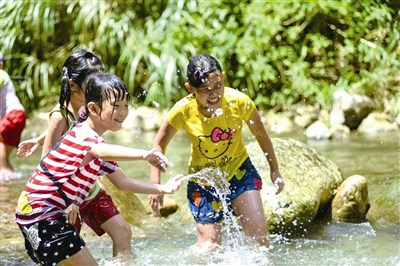 孩子們在平溪森林小學會館旁戲水,在坪林英速魔法學院學做甜點、觀賞生態,精彩活動在偏鄉廢校輪番上演。圖/莊坤儒
孩子們在平溪森林小學會館旁戲水,在坪林英速魔法學院學做甜點、觀賞生態,精彩活動在偏鄉廢校輪番上演。圖/莊坤儒
提 要
山之巔、海之角,一所所偏鄉的學校在學生不斷流失下,難逃廢校命運。如今,地方政府、民間單位相繼投入,讓掩蓋在荒煙蔓草中的校園,重獲春天。廢校改造計畫正在各地不斷上演,他們變身為生態園地、藝術創作場域或國際化的學習空間,再次充滿人聲與笑語。
In late July, a dozen-odd students and teachers from a tutoring center in Jingmei, Taipei City, arrive for a stay at the Forest School(formerly Dongshi Elementary School)in Pingxi, a rural district of New Taipei City. The excited chattering of kids fresh from the city blends with the buzzing of insects, the singing of birds, and the burbling of the nearby creek, seemingly turning the clock back 20 years to a time when the voices of happy children filled a still-active school.
Kuolai Elementary School is bustling with unusual activity as well. Located in a small village in New Taipei City’s Pinglin District, the school is hosting 70-some elementary school students. They have come with a handful of American, Australian and Canadian teachers to learn about the natural environment, including the endangered Taiwan blue magpie and Formosan rock macaque. The sound of recitations carries out of classrooms, breaking a silence that has hung over the school since its shuttering.
Dongshi Elementary is a case in point. An old school with a great deal of history, it was successfully transformed through the joint efforts of the Pingxi District Farmers’ Association(PDFA)and Pingxi Elementary School.
The campus was largely deserted for more than a decade and was falling ever further into disrepair until the PDFA intervened in 2007. Chen Chin-li, head of the PDFA’s promotion section and a participant in the school renovation project, says that the PDFA got involved to create a source of revenue for itself.
The old school underwent six months of renovations before being reintroduced to the world as the Forest School in September 2007. The class plaques still hanging outside the six classrooms and the blackboards in the dormitories create a school-like atmosphere in an otherwise natural setting complete with fireflies and a babbling brook. It drew 673 visitors in its first year with no advertising at all.
The development of the school has also spurred local employment. The Forest School’s revenues grew from something over NT$100,000 in 2006 to more than NT$3 million in 2013, and more than 10,000 people visit every year, making the PDFA the first agricultural organization in Taiwan to successfully repurpose a shuttered school.
Opened in 1911, Kuolai was once one of three elementary schools serving the Pinglin area. Located in a water source protection area, Pinglin has long faced severe limits on its development and large numbers of residents have relocated to Taipei for work. By the time the school closed in 1987, it had just five or six students, all of whom were subsequently transferred to Pinglin Elementary.
The nearby Beishi Creek gifted the school with a rich and largely untouched ecosystem that at one time made it a popular camping destination for schoolchildren from Taipei County. When its scouts’ campground was moved to another facility, the campus became silent once more.
That changed in 2008 when the Taipei County Government began using shuttered schools to host English language camps.
Liu Fengyi is the principal of Pinglin Elementary and was a participant in the reconstruction of Kuolai. She explains that the camps are intended to provide disadvantaged students from remote areas with a means of learning English. “The idea is to give these kids, who have few resources of their own, the opportunity to experience the atmosphere of overseas language study, and to get them more comfortable with speaking English.”
The school’s renovations included putting glass exterior walls on the classrooms and bringing elements of the surrounding ecosystems inside to create international-style learning spaces that retain a local feel. In its initial phase, camp attendance was limited to students from small schools, providing them with three-day, two-night courses that allowed them to study English in a natural, outdoorsy setting.
Kuolai’s rebirth has also made it something of a local attraction. Liu says that the original school was funded with donations and closely connected to the surrounding community.
翻 譯
七月下旬,台北景美一所安親班十多位師生來到前身為新北市平溪東勢國小的森林國小會館,準備下榻在這處蟲鳴鳥叫盈耳、溪水潺潺流過的空間。城市來的小朋友們興奮地交談,彷彿重回二十年前,學校尚未關閉時,笑聲滿盈的時光。
位於新北市坪林區的闊瀨國小,同樣熱鬧非凡。七十多位中高年級國小學生,跟著美、澳、加外籍老師認識保育動物藍鵲、獼猴及自然生態。教室裡傳來的複誦聲,打破了廢校以來的寂靜。
歷史悠久的平溪東勢國小,就在平溪農會與平溪國小的合作下,成功轉型。十多年來,校園人跡罕至,日益頹圮,直到民國九十六年平溪農會進駐後,才起死回生。平溪農會推廣股股長陳欽黎即是當年參與東勢分校改造計畫的一員。他表示,平溪農會投入廢校改造,是為了開闢財源。
經過半年整修,九十六年九月,平溪國小東勢分校以全新的森林小學會館問世。六間教室裝上班級門牌,寬敞的通鋪還有著黑板,讓遊客身處在校園氣息裡,賞螢、溯溪,體驗大自然。第一年在全無宣傳的狀況下,竟吸引了六百七十三人到訪。
森林小學會館的口碑漸傳,農會也趁勢推出「東勢景點搜密行程」、「平溪國小東勢分校攝影大賽」等特色行程,搭上時興的農業觀光熱潮,打響知名度。藉著森林小學會館的行銷,也促進地方就業。
經過七年多的經營,森林小學會館的營收從九十五年的十多萬元,成長至一○二年的三百多萬元,每年有上萬遊客到訪,成功推動了東勢國小的重生。平溪農會成為全台第一個投入廢校經營有成的農業單位,並以創新的農村再生模式,贏得農委會「金推獎」的榮耀。
民國元年設校的闊瀨國小,歷史悠久,是坪林地區僅有的三所小學之一。但因坪林位處水質保護區,開發受限,缺乏工作機會的民眾大量外移至台北市,使得學生人數不斷下滑。七十六年廢校前夕,僅剩下五、六名學童,只好併入坪林國小。
闊瀨國小因緊鄰北勢溪,有著原始豐富的自然生態,一度被用作台北縣童子軍露營營地,成為熱門的野外營地。後又因童軍社團陣地移往他處,沉寂多時。
民國九十七年,時值台北縣(現升格為新北市)政府利用偏鄉閒置校舍,打造「英速魔法學院」,提供偏鄉學童在地化的外語學習空間。
參與改造的坪林國小校長劉鳳儀表示,由新北市政府推動的英速魔法學院,是為了提供偏鄉的弱勢學子學習外語管道。「讓少有資源的他們也能體驗海外遊學的氛圍,不再害怕說英文,」她說。
改建後的校區,不僅有現代化的透明教室,並融入闊瀨周邊的生態景觀特色,打造為一處既在地又國際的學習空間。初期即鎖定新北市中小型學校,提供三天兩夜戶外課程,讓學生浸淫大自然中,學英語。闊瀨校園重獲新生後,甚至成為在地的新據點。
文/劉嫈楓 圖/莊坤儒
摘錄轉載自103年10月《台灣光華雜誌》
全文請參考
http://www.taiwan-panorama.com/
對 話
in the library
Adam: How may I help you?
Betty: I couldn’t find the book I was looking for.
Adam: Have you checked the database?
Betty: I checked.
Adam: Was it on the shelf?
Betty: It should have been, but it wasn’t.
Adam: Maybe someone took it.
Betty: Will you be getting another copy anytime soon?
Adam: I’m sure we will.
Betty: Would you be able to reserve it for me?
Adam: I sure will.
Betty: Thank you very much.
在圖書館
亞當:我能幫你什麼嗎?
貝蒂:有一本書我想找卻一直找不到。
亞當:你有沒有檢查書籍資料庫?
貝蒂:查過了。
亞當:那書架上沒有嗎?
貝蒂:書應該在,但書架上沒有。
亞當:也許有人拿走了。
貝蒂:最近會有一本可供閱讀嗎?
亞當:應該會的。
貝蒂:那是否能幫我保留?
亞當:那當然可以。
貝蒂:非常感謝你。